
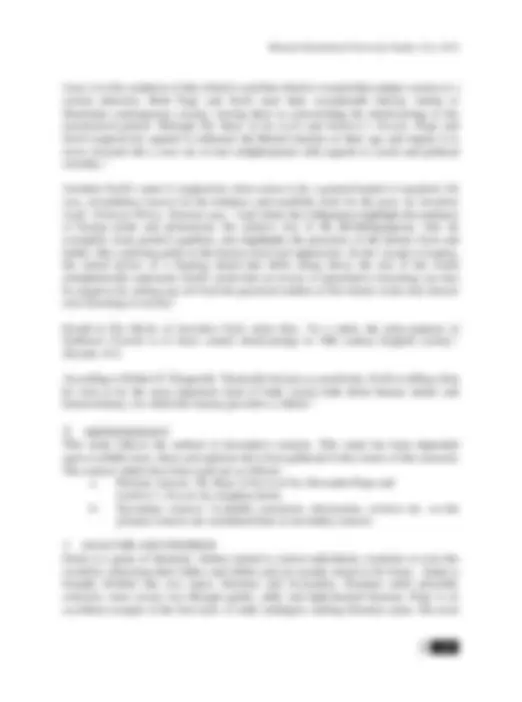
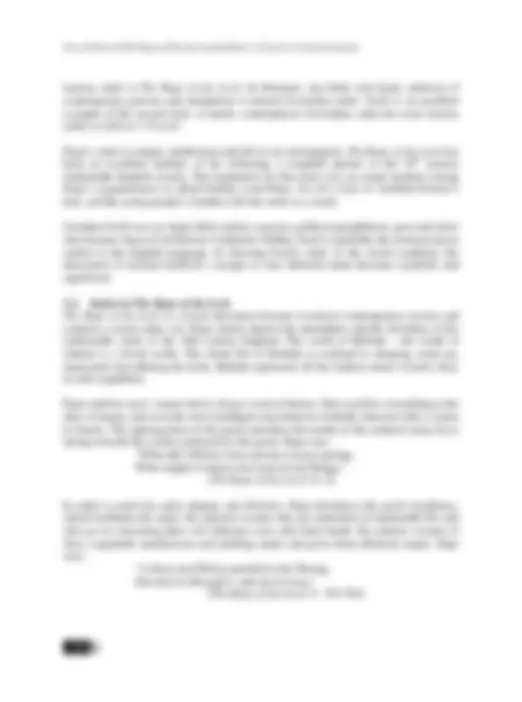
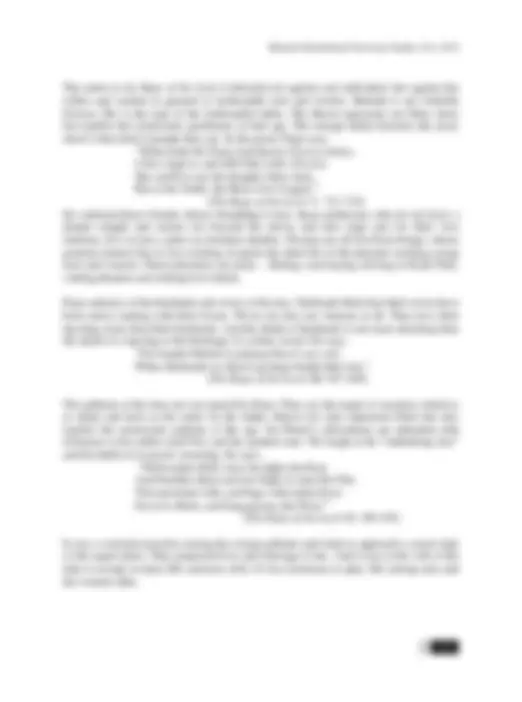
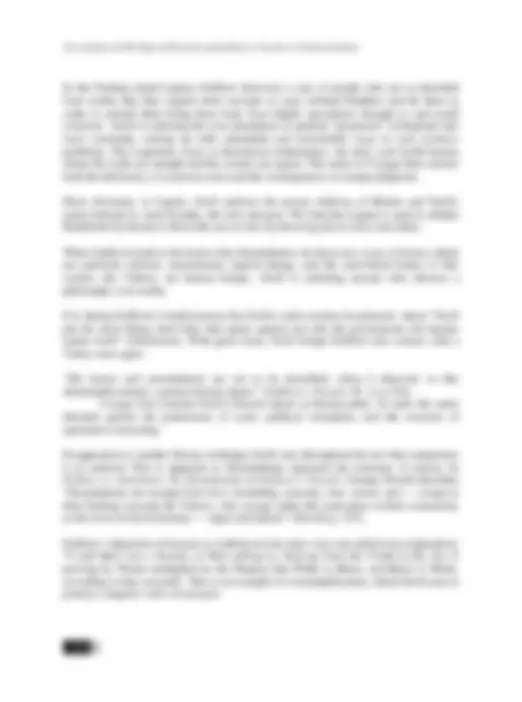

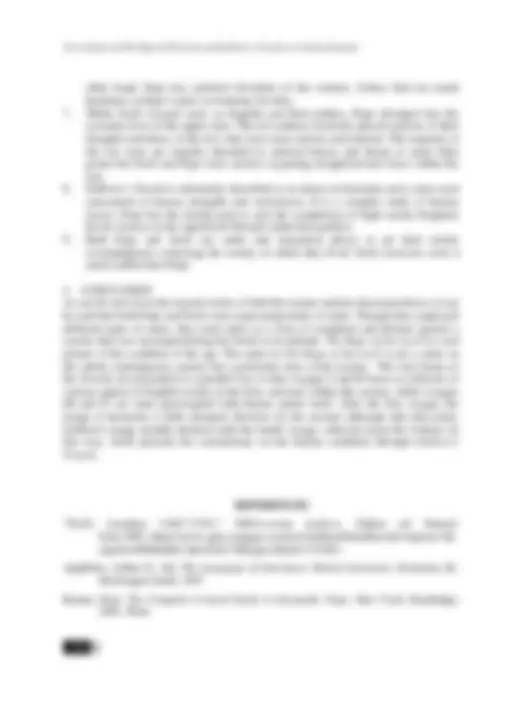


Study with the several resources on Docsity

Earn points by helping other students or get them with a premium plan


Prepare for your exams
Study with the several resources on Docsity

Earn points to download
Earn points by helping other students or get them with a premium plan
Community
Ask the community for help and clear up your study doubts
Discover the best universities in your country according to Docsity users
Free resources
Download our free guides on studying techniques, anxiety management strategies, and thesis advice from Docsity tutors
Use of Satire In The Rape of The Lock and Gulliver's Travels: A Critical Analysis. 148 satirical literature carried a higher purpose, with an explicit moral ...
Typology: Study notes
1 / 11

This page cannot be seen from the preview
Don't miss anything!







Manarat International University Studies, 5(1), 2015
Mahbuba Sultana ∗
Satire is a genre of literature in which vices, follies, abuses, and shortcomings are held up to ridicule, ideally with the intent of shaming individuals, and society itself, into improvement. Writers of the Augustan Age were revered for their wit and satirical works as they managed to portray the evils of their period through it. This paper discusses with Alexander Pope and Jonathan Swift have portrayed society through satire. It also shows the style and significance, the similarities and dissimilarities in their use of satire. The main focus of this study will be on Alexander Pope’s The Rape of the Lock and Jonathan Swift’s Gulliver’s Travels, in terms of their satirical elements. In The Rape of the Lock, Pope satirizes the aristocratic women and men, their activities, the professional judges and politicians of the day etc. On the other hand, through Gulliver's Travels, Swift attempted to satirize the pride of the eighteenth century English people as well as human as species on earth. The methodology used in this study is analytic.
Keywords: Satire, Pope, Swift, Society, Galliver.
Most of the literature contains the writers' ideas of the social criticism. One of the most prominent forms used to bring reform or change in the society or in individuals is that of satire. “Satire is a literary technique in which behaviors or institutions are ridiculed for the purpose of improving society.” (Applebee, 1997, p. 584). This study compares the use of satire between Alexander Pope and Jonathan Swift and deals with Pope’s famous mock epic The Rape of the Lock and Swift’s novel Gulliver’s Travels. Pope wrote this mock epic in order to satirize English aristocracy in general and a specific event between two prominent Catholic families. Whereas, Swift's satire is inspired by what seems to be a general hatred of mankind. Gulliver’s Travels , along with other Eighteenth Century
∗ (^) Senior Lecturer, Department of English, Manarat International University, Gulshan, Dhaka. Email: msultana_sust@yahoo.com
Use of Satire In The Rape of The Lock and Gulliver’s Travels: A Critical Analysis
satirical literature carried a higher purpose, with an explicit moral intention; it functioned as a method of constructive social criticism. Swift was a man of piercing intellect and this intellect showed the chaos, confusion and corruption of the eighteenth-century England. This paper intends to focus on the similarities and dissimilarities of these two authors in their use of satire.
1.1. Objectives of the Study The objectives of the study are as follows: a. To show how Alexander Pope and Jonathan Swift use satire in their writings. b. To exhibit the resemblances and the dissimilarities between Alexander Pope and Jonathan Swift in their ways of representing satire. c. To explore how satire has been regarded as an indispensable and most effective source of their writings to understand a society.
1.2. Literature Review Much of the work has been done on Pope and Swift. In most of this research, the major concern has been on satire, the golden age of satire, Pope and Swift. In this paper researcher tries to show the ways of using humour in literature of these prominent writers. Stephen Holliday says, “ The Rape of the Lock is widely-considered the best mock-heroic (mock- epic) poem in all of English literature. Pope took as his subject an actual affair in which Lord Petre snipped off a lock of Miss Arabella Fermor's hair, which caused such a dispute within a small niche of upper-class English society. Pope’s satire succeeds because he demonstrates the gulp between the foolishness of the ‘rape’ of hair and the very real consternation it caused in the upper-class participants and, in the end, the readers are forced to conclude, while laughing, that both the incident itself and the people involved are absurd.”
In the essay “Satire in 18th Century British Society: Alexander Pope's The Rape of the Lock and Jonathan Swift's A Modest Proposal ”, Jonathan J. Szwec says, “Satires during this period aimed to point out the shortcomings of society through ridiculing accepted standards of thought, exposing Britain’s flaws and chastising the hypocrisy of the time. Enlightenment writers Alexander Pope and Jonathan Swift used different mediums of satire, different types of logic, and different targets of ridicule in order to shine a light on separate aspects of British society, providing much-needed criticism of the profuse moral corruption of a society that sometimes seemed to forget the true ideals of its age.”
Jonathan J. Szwec also says, “The satirical works of Pope and Swift express their authors’ profound dissatisfaction with their society. Literature that pushes for reform of any kind, social or political, acts, along with entrenched tradition itself, as a dialectic
Use of Satire In The Rape of The Lock and Gulliver’s Travels: A Critical Analysis
famous satire is The Rape of the Lock. In literature, any bitter and ironic criticism of contemporary persons and institutions is termed Juvenalian satire. Swift is an excellent example of the second style: of harsh, contemptuous Juvenalian satire his most famous satire is Gulliver's Travels.
Pope’s satire is unique, intellectual and full of wit and epigram. The Rape of the Lock has been an excellent medium of his reflecting a complete picture of the 18th^ century fashionable English society. The inspiration for the poem was an actual incident among Pope’s acquaintances in which Robert, Lord Petre, cut off a lock of Arabella Fermor’s hair, and the young people’s families fell into strife as a result.
Jonathan Swift was an Anglo-Irish satirist, essayist, political pamphleteer, poet and cleric who became Dean of St Patrick's Cathedral, Dublin. Swift is probably the foremost prose satirist in the English language. In showing Swift's satire of the social condition, the discussion of Lemuel Gulliver's voyages to four different lands becomes symbolic and significant.
3.1. Satire in The Rape of the Lock The Rape of the Lock is a social document because it mirrors contemporary society and contains a social satire, too. Pope clearly depicts the absurdities and the frivolities of the fashionable circle of the 18th century England. The world of Belinda – the world of fashion is a trivial world. The whole life of Belinda is confined to sleeping, make-up, enjoyment and alluring the lords. Belinda represents all the fashion struck women, busy in such stupidities.
Pope satirizes man’s nature that is always weak at beauty. Men sacrifice everything at the altar of beauty and even the most intelligent man behaves foolishly when he falls a victim to beauty. The opening lines of the poem introduce the reader to the satirical stance he is taking towards the society portrayed in the poem. Pope says, “What dire Offence from am'rous Causes springs, What mighty Contests rise from trivial Things,” [ The Rape of the Lock : I.1-2]
In order to make his satire sharper and effective, Pope introduces the aerial machinery, which facilitates the satire. He satirizes women who are interested in fashionable life and who go on exercising their evil influence even after their death. He satirizes women of fiery, coquettish mischievous and yielding nature and gives them different names. Pope says, “A Beau and Witling perish'd in the Throng, One dy'd in Metaphor , and one in Song .” [ The Rape of the Lock : V. 703-704]
Manarat International University Studies, 5(1), 2015
The satire in the Rape of the Lock is directed not against any individual, but against the follies and vanities in general of fashionable men and women. Belinda is not Arabella Fermor. She is the type of the fashionable ladies. The Baron represents not Petre alone but typifies the aristocratic gentleman of that age. The strange battle between the sexes shows what kind of people they are. In the poem, Pope says, “When bold Sir Plume had drawn Clarissa down, Chloe stept in, and kill'd him with a Frown; She smil'd to see the doughty Hero slain, But at her Smile, the Beau reviv'd again.” [ The Rape of the Lock : V. 711-714] He satirized those friends whose friendship is lust, those politicians who do not have a deeper insight and cannot see beyond the shows and take steps just for their own interests. It is in fact a satire on feminine dandies. Women are all frivolous beings, whose genuine interest lies in love-making. It paints the ideal life of the pleasure-seeking young men and women. These pleasures are petty – flirting, card-laying, driving in Hyde Park, visiting theatres and writing love-letters.
Pope satirizes of the husbands and wives of the day. Husbands think that their wives have been merry making with their lovers. Wives are also not virtuous at all. They love their lap-dogs more than their husbands. And the death of husbands is not more shocking than the death of a lap dog or the breakage of a china vessel. He says, “Not louder Shrieks to pitying Heav'n are cast, When Husbands or when Lap-dogs breath their last,” [ The Rape of the Lock : III. 447-448]
The gallants of the time are not spared by Pope. They are the target of mockery which is as sharp and keen as the satire on the ladies. Baron not only represents Petre but also typifies the aristocratic gallants of the age. Sir Plume's affectations are ridiculed with reference to his amber snuff-box and his spotted cane. We laugh at his "unthinking face" and his habit of excessive swearing. He says, “With tender Billet-doux he lights the Pyre, And breathes three am'rous Sighs to raise the Fire. Then prostrate falls, and begs with ardent Eyes Soon to obtain, and long possess the Prize:” [ The Rape of the Lock : II. 189-192]
It was a common practice among the young gallants and lords to approach a sweet lady of the equal status. They proposed love and marriage to her. And it was at the will of the lady to accept or reject this amorous offer. It was customary to play flirt among men and the women alike.
Manarat International University Studies, 5(1), 2015
case, not on their ability to walk a tightrope but on their connections within the court. In another instance, Swift, through Gulliver, criticizes the religious animosity within English society by telling us about the hatred between those Lilliputians who open their eggs from the small end or the large end first. The two political parties being differentiated by the height of their heels points out how little substantive difference there was between Whig and Tory. Gulliver explains that, “there have been two struggling parties in this Empire, under the names of Tramecksan and Slamecksan , from the high and law heels on their shoes, by which they distinguish themselves.” [ Gulliver's Travels : I. iv. p- 33]
The methods of selecting people for public office in Lilliput are very different from that of any other nation. In order to be chosen, a man must "rope dance" to the best of his abilities; the best rope dancer receives the higher office. Gulliver is surprised “when a great office is vacant either by death or disgrace (which often happens) five or six of those candidates petition the Emperor to entertain his Majesty and the Court with a dance on the rope, and whoever jumps the highest without falling, succeeds in the office. ………….Flimnap, the Treasurer, is allowed to cut a caper on the straight rope, at least an inch higher than any other lord in the whole empire.” [ Gulliver's Travels : I. iii. p-23] Here Swift satirizes such an absurd practice of selecting officers in Europe.
In Gulliver’s second voyage, he finds himself in a strange land, where everything around him many times the normal size. When he encounters the first natives, he fears for his life, "for as human creatures are observed to be more savage and cruel in proportion to their bulk" [ Gulliver's Travels : II. i. p-73]. While in Lilliput Gulliver had been treated with respect, largely due to his size; here in this land of giants, Brobdingnag, he is treated as a curiosity. Gulliver tells us: “I would hide the frailties and deformities of my political mother, and place her virtues and beauties in the most advantageous light. This was my sincere endeavor in those many discourses I had with that mighty monarch, although it unfortunately failed of success.” [ Gulliver's Travels : II.vii. p-119]. In contrast, Brobdingnagian society has many things to recommend it such as excellence "in morality, history, poetry, and mathematics," although Gulliver ironically laments that these are only applied to the practical aspects of life and not used for abstractions. The main focus of social criticism in the voyage to Laputa is on intellectuals, such as scholars, philosophers, and scientists, who often get lost in theoretical abstractions and conceptions to the exclusion of the more pragmatic aspects of life, in direct contrast to the practical Brobdingnagians.
Use of Satire In The Rape of The Lock and Gulliver’s Travels: A Critical Analysis
In the floating island Laputa, Gulliver discovers a race of people who are so detached from reality that they require their servants to carry inflated bladders and hit them in order to remind them bring them back from highly speculative thought to real-world concerns. Swift is satirizing the over-abundance of genuine "projectors" in England who were constantly coming up with outlandish and unworkable ways to cure society's problems. The Laputians excel at theoretical mathematics, but they can't build houses where the walls are straight and the corners are square. The satire in Voyage three attacks both the deficiency of common sense and the consequences of corrupt judgment.
Most obviously, in Laputa, Swift satirizes the power relations of Britain and Swift's native Ireland or, more broadly, the rich and poor. We find that Laputa is used to subdue Balnibarbi by threats to block the sun or rain, by throwing down rocks onto them.
When Gulliver lands in the land of the Houyhnhnms, he discovers a race of horses which are perfectly rational, unemotional, logical beings, and the uncivilized brutes of this society, the Yahoos, are human beings. Swift is satirizing anyone who chooses a philosophy over reality.
It is during Gulliver's fourth journey that Swift's satire reaches its pinnacle, where "Swift put his most biting, hard lines that speak against not only the government, but human nature itself" (Glicksman). With great irony, Swift brings Gulliver into contact with a Yahoo once again.
"My horror and astonishment are not to be described, when I observed, in this abominable animal, a perfect human figure;" [ Gulliver's Travels : IV. ii. p-218]. Voyage four contains Swift's clearest attack on human pride. As such, the satire directed against the pretensions of court, political corruption, and the excesses of speculative reasoning.
Exaggeration is another literary technique Swift uses throughout the text that categorizes it as satirical. This is apparent as Houyhnhnms represent the extremes of reason. In Politics vs. Literature: An Examination of Gulliver’s Travels , George Orwell describes “Houyhnhnms are exempt from love, friendship, curiosity, fear, sorrow and — except in their feelings towards the Yahoos, who occupy rather the same place in their community as the Jews in Nazi Germany — anger and hatred.” (Orwell, p. 333).
Gulliver’s depiction of lawyers is scathing in tone and a very one-sided in its explanation: “I said there was a Society of Men among us, bred up from the Youth in the Art of proving by Words multiplied for the Purpose that White is Black, and Black is White, according as they are paid”. This is an example of oversimplification, which Swift uses to portray a negative view of Lawyers.
Use of Satire In The Rape of The Lock and Gulliver’s Travels: A Critical Analysis
other hand, Pope has satirized frivolities of the women. Critics find too much harshness in Pope's satire on feminine frivolity.
“Swift, Jonathan (1667-1745).” DISCovering Authors. Online ed. Detroit: Gale,2003.<http://www.gale.cengage.com/servlet/ItemDetailServlet?region=7&i mprint=000&titleCode=GAL70&type=4&id=174769>.
Applebee, Arthur N., Ed. The Language of Literature: British Literature. Evanston, IL: McDougal Littell, 1997
Baines, Paul. The Complete Critical Guide to Alexander Pope. New York: Routledge;
Manarat International University Studies, 5(1), 2015
Cummings, Michael J. Gulliver’s Travels. Cummings Study Guide. 18 March 2008 http://www.cummingsstudyguides.net/Gulliver.html.
Dobree, Bonamy. English Literature in the Early Eighteenth Century. Oxford, Great Britain: Oxford University Press, 1959.
Downie, J. A. Jonathan Swift: Political Writer. London: Routledge and Kegan Paul,
Ewald, William Bragg. The Masks of Jonathan Swift. Oxford, Great Britain: Basil Blackwell, 1954.
Lock, F. P. The Politics of Gulliver's Travels. Oxford, Great Britain: Oxford University Press, 1980.
Pope, Alexander. The Rape of the Lock. Longman Anthology of British Literature. Ed.
Robert P. Fitzgerald, The Structure of ‘Gulliver’s Travels’ , Studies in Philology, Vol. 71, No. (Apr., 1974), pp. 247-263), University of North Carolina Press.
Swift, Jonathan. Gulliver's Travels. Mahwah, NJ: Watermill Press, 1983.